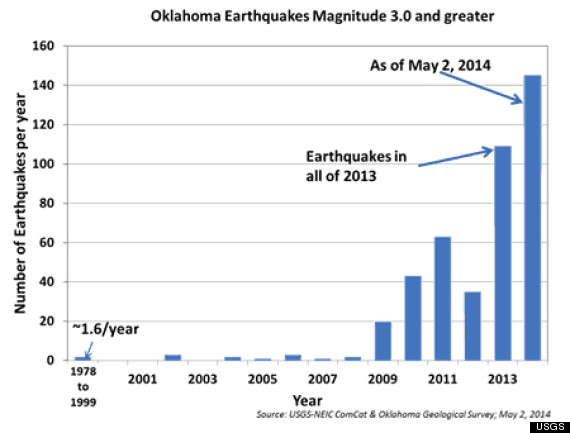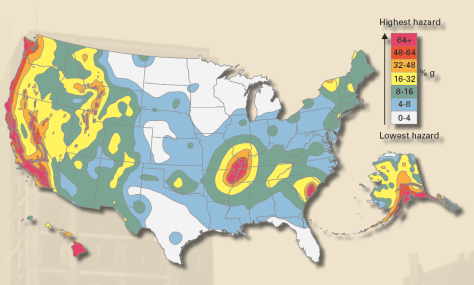The United States Geological Survey issued a statement, suggesting that hydraulic fracturing as possibly leading to the rise in earthquakes in Oklahoma. On January 17, 2014, it reviewed literature on hydrofracking and earthquakes. It noted the coincidence of hydrofracking and increased earthquakes, and it posited that there could be a causal relationship.
The Oklahoma analysis suggests that a contributing factor to the increase in earthquakes occurrence may be from injection-induced seismicity from activities such as wastewater disposal. The OGS [Oklahoma Geological Survey] has examined the behavior of the seismicity through the state assessing the optimal fault orientations and stresses within the region of increased seismicity, particularly the unusual behavior of the swarm just east of Oklahoma City. . . . . As the use of injection for disposal of wastewater increases, the importance of knowing the associated risks also grows. To meet these challenges, the USGS hopes to increase research efforts to understand the causes and effects of injection-induced earthquakes.Since then, eight small earthquakes were reported in the space of 30 hours in Oklahoma, CBS News reported yesterday. Their effects were felt in neighboring Kansas and Texas as well. They were of 2.6 to 4.3 magnitude. Earthquakes have been increasingly frequent in the state. In fact, the state had more quakes in the state than California in the first three months this year.
This May the U.S.G.S. made a rare warning on earthquake risk in Oklahoma, the Huffington Post reported. It said that the state risked a damaging, larger than 5.0 Richter quake. This was the first time that the agency issued such a warning east of the Rocky Mountains.
Oklahoma historically has not been seen as an area of great seismologic activity. Austin Holland said that the state is experiencing unprecedented levels of earthquakes. He added that the kinds of fracturing drills are the same sort that have been used for years, however, frequent earthquakes did not become a problem until 2009. The 250 small to medium quakes the state has experienced since January are greater than the number of 3.0 or greater quakes in all of the continental U.S. this year.
Yet, with fracking the state is seeing an increasing number of earthquakes.

* * *
One would think that this will hurt the case for building nuclear power plants in Oklahoma. In the 1980s unsuccessful attempts were made to build the Black Fox Nuclear Power Planet, which would have been within 30 miles of Tulsa.
Nonetheless, perhaps residents and environmental activists in adjacent Arkansas would have cause for concern.The northwestern Arkansas Nuclear One plant, with two units, owned by Entergy Nuclear, would perhaps be vulnerable to earthquake tremors. The plant experienced an accident in a non-nuclear area, killing one worker and injuring eight others. It was placed offline for a week before it was restored to service. A 2010 Nuclear Regulatory Commission study placed the odds of the reactor being subject to core damage from an earthquake to be 1:243,902.
Arkansas is in the middle range of areas under risk of earthquake damage. See the map below.

(Source, NBC News, "What Are the Odds? U.S. Nuke Plants Ranked By Quake Risk, So Much For San Andreas: Reactors in East, Midwest, South Have Greater Risk")
Of note: the 37 year old plant has the same containment system as that used in the Fukushima Daiichi nuclear reactor. (source: How close is your home to a nuclear power plant?, CNN, 2014) The Arkansas plant is 60 miles northwest of Little Rock. The population within 50 miles of the plant, according to the 2010 U.S. census, is 308,218.
* * *
The same NBC News source for the above map notes that the nuclear power plant most vulnerable from effects of an earthquake would be the New York City metropolitan area (and the lower Hudson River Valley).
And it turns out that the nuclear reactor in the United States with the highest risk of an earthquake causing core damage is not the Diablo Canyon Power Plant, with its twin reactors tucked between the California coastline and the San Andreas Fault.There are more than 20 million people living within 50 miles of the Indian Point nuclear plant reactors, which are 24 miles north of New York City. In 2011 a column in the New York Times suggested that evacuation contingencies are unrealistic. It cited a 2003 then governor George Pataki commissioned study said that current response plans were inadequate. And the column closed with a note that current governor Andrew Cuomo, in the wake of the Fukushima plant disaster in Japan, said that the plant poses too great a risk to remain open, citing the fact that the plant lies on a fault line. Well, this was three years ago. Where is governor Cuomo on this safety issue? In April Capital New York noted that the governor is in a political quandry because the plant supplies one fourth of New York City's power and 12 percent of the energy in the state. However, it did note that there was precedent: 25 years ago his governor father Mario Cuomo closed the Shoreham nuclear plant on Long Island, by implementing a state takeover of the plant. This was the first dismantling of a nuclear power plant in the U.S.
It's not the San Onofre Nuclear Generating Station, a four-hour drive down the Pacific coast at San Clemente, surrounded by fault lines on land and under the ocean.
It's not on the Pacific Coast at all. It's on the Hudson River.
One in 10,000
The reactor with the highest risk rating is 24 miles north of New York City, in the village of Buchanan, N.Y., at the Indian Point Energy Center. There, on the east bank of the Hudson, Indian Point nuclear reactor No. 3 has the highest risk of earthquake damage in the country, according to new NRC risk estimates provided to msnbc.com.
The NBC report closes with a 2008 NRC list ranking the various 104 U.S. plants by their risk of nuclear reactor core damage from an earthquake. The Arkansas and North Texas come out as being at lesser relative risk. The ten worst risk are all in the East. They are from first to tenth in risk, Buchanan (Westchester County), NY, Plymouth, Mass., Limerick, Pa., Soddy-Daisy, Tenn., Shippingport, Pa., Jensen Beach, Fla., Louisa, Va. (Some locations have multiple reactors, and so, there are multiple rankings.) As NBC noted, the Indian Point, Buchanan, NY risk ranking, almost require under the NRC guidelines immediate attention to properly protect the public.
The base estimates are not based strictly on the Richter measured wave of the quake, but of how much the ground will shake.
Instead, these risk estimates consider how violently the ground will shake at the nuclear plant, considered a better indication of how much damage it will cause. That shaking can be affected by the depth, distance from the epicenter, and the frequencies of waves that the quake emits. The shaking is expressed in a unit called peak ground acceleration, in terms of the acceleration caused by the Earth's gravity. This is a measure of intensity.Comparing states, comparing policies Ohio, citing recent earthquakes, enacted a moratorium in March, in an order by the Ohio Natural Resource Department. Yet, in New York State, governor Andrew Cuomo is waiting for the results of a health study. That health study, which has been going for about two years, has been criticized for being conducted in a secretive process. Because of the resistance from Cuomo and the health department, the Seneca Lake Pure Water Association has filed a Freedom of Information Law (FOIL) request to get the information. By contrast, his Green Party challenger for governor, Howie Hawkins, since at least 2013, has favored a statewide ban on hydrofracking.
*Home rule trumps Cuomo's avoiding a permanent policy
This issue of seeking a ban should be restated as a permanent ban. For, New York State has a temporary moratorium on fracking until a decision can be made on how to regulate, once the health impact determination has been made. David Paterson instituted a moratorium on hydraulic fracturing in the state by an executive order on December 12, 2010. That seven month moratorium remains in effect. However, on June 30 New York State Court of Appeals ruling allowed towns to exert local control if they wish to bar fracking.
*Pennsylvania, the regional exception practicing fracking
Thus with New York's moratorium where else in the Northeast is fracking practiced? Not in New Jersey. Thus far, no gas shale reserves from the Marcellus Shale have been discovered yet. This has not stopped current governor Chris Christie from stating his declared opposition to any anti-fracking legislation in the Garden State. The remaining fight is over banned fracking waste in New Jersey. At least three communities in the state have received the waste, Carteret, Elizabeth, and Pennsville, according to environmentalists. An anti-frack waste bill passed in both houses, but as the Newark Star-Ledger noted, Gov. Christie vetoed similar legislation two years ago.
This leaves Pennsylvania as the only state in the northeast where fracking is practiced. Hence, the concentration of "fraccidents" in Pennsylvania in the map below.
(Source: Earth Justice, "New Jersey and Fracking;" see Trevor, "Fraccidents Map", for a continental U.S. and Canada map on fracturing accidents. These maps are ca. 2014, possibly regularly updated.)



















No comments:
Post a Comment